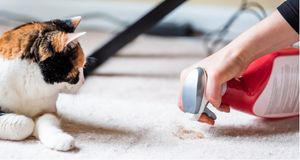
How to deal with cat hairballs: Feline Hacks
You’re probably familiar with cat hairballs if you have a long-haired cat (or really any cat that isn’t bald). Knowing how to deal with the issue can significantly help you in the long run, even though it’s not the most endearing thing about your feline friend.
Hairballs can be a little overwhelming because you might think there’s something more serious going on. If you are able to recognize the signs, you can help your cat more effectively.
Often, cats groom themselves by licking their fur, and this is where the problem begins. If you’ve ever felt your cat’s tongue, you know how rough it is. The backward-facing barbs on your cat’s tongue help it groom. Because these barbs face backwards, they prevent anything that enters your cat’s mouth from going anywhere but down.
Cat hairballs, or trichobezoars, are caused by ingesting hairs. A mat or ball of hair will form within your cat’s digestive system as the tongue picks up hair. It is possible for shorthair cats to develop cat hairballs as well, they just do so less frequently because they have less fur to ingest. The process is normal for cats, and they usually pass the hairball without any problems.
Many cat owners who have come home to a hairball on their floor know that this isn’t always the case. Occasionally, a hairball can block parts of your cat’s stomach or digestive tract. If the blockage prevents food from entering the stomach, it may cause gastrointestinal distress. It can also cause constipation as it works its way through your cat’s system.
Your cat may exhibit some of the obvious signs of a hairball, such as vomiting or regurgitation.
What to Look for When Your Cat Has Hairballs
If your cat brings up a hairball, it might sound like a dry cough or as if something is stuck in its throat. Fluids or food may also precede it. While their body is dealing with a hairball, your cat might also experience constipation.
If your cat has a hairball, there are several things you can do to help them. If you know what to look for, cat hairballs can be a much less stressful experience.
Grooming your cat is the most important thing you can do for it. When you groom your cat frequently, you’ll be doing most of the work and your cat will ingest fewer stray hairs. The more hair your cat has, the more grooming you’ll have to do. In order to prevent your cat from developing hairballs, you should groom them once a day. Keeping your cat’s skin healthy and free of tangles and mats is also important with daily brushing.
Cats can also pass hairballs with the help of specific products. Your cat can pass hairballs easily and quickly by using these laxatives and lubricants. They often come in a paste form, so your cat won’t have a problem eating them, and they have a pleasant taste. Alternatively, you can apply it to your cat’s paws to get them to lick it off.
Many pet food brands also offer types that prevent hairballs. It is common for these foods to have a high fiber content in order to help your cat pass any hairballs they might have.
Another way to help your cat pass hairballs is to give him hairball remedy treats. By containing mineral oil, these treats prevent blockages caused by hairballs. In order to prevent further problems with hairballs, these products are mainly designed for cats who deal with them frequently.
You should discuss any of these options with your veterinarian. Moreover, you should recognize that each cat is different, and one product might work for one cat, but not for another. A veterinarian can help you determine the best course of action.
It is important to note that vomiting a hairball is not a common occurrence. It may be a sign of a deeper issue if your cat throws up hairballs frequently. If a problem like this persists, consult your veterinarian.





